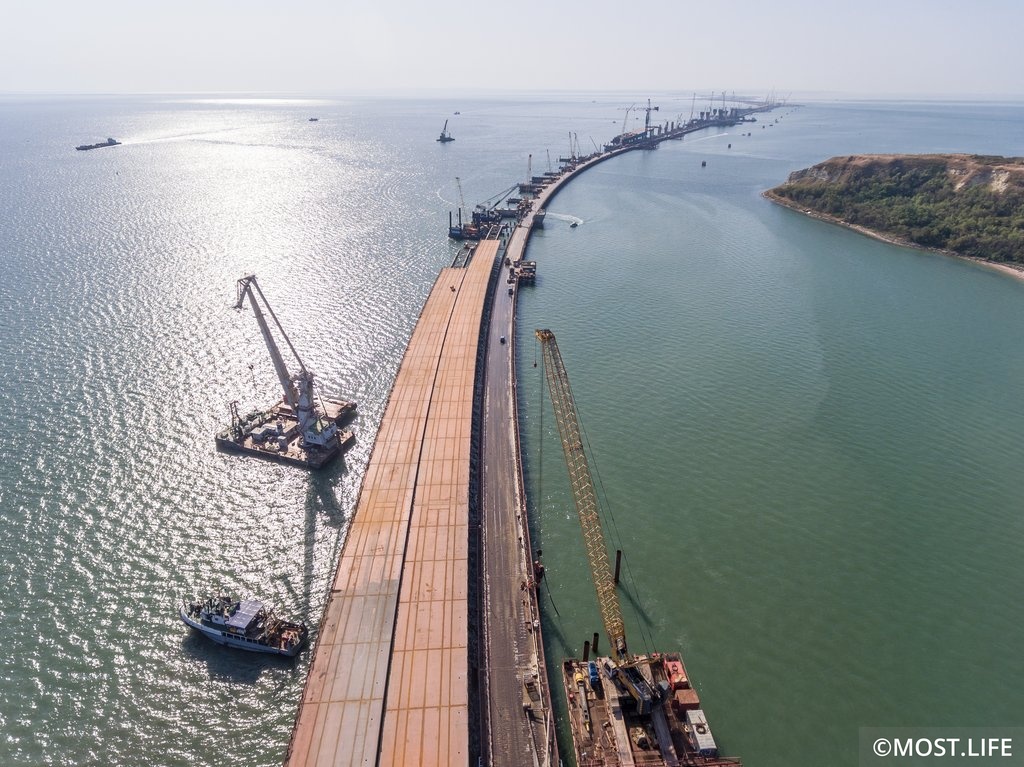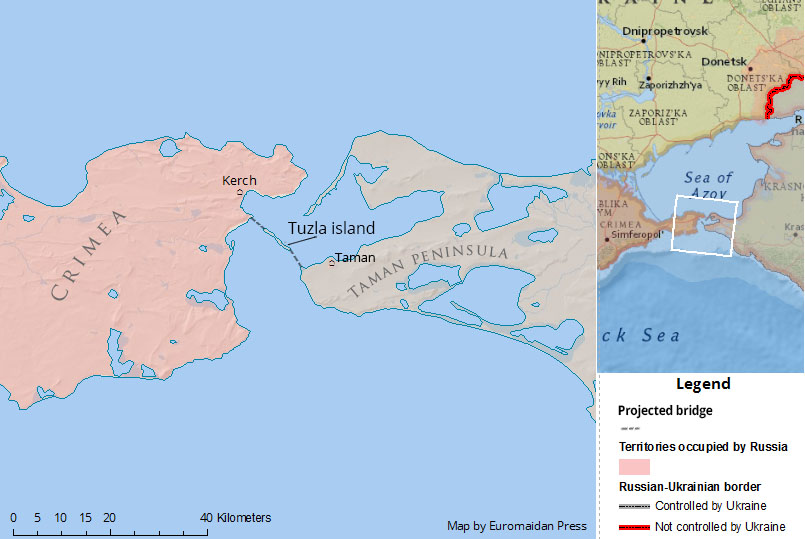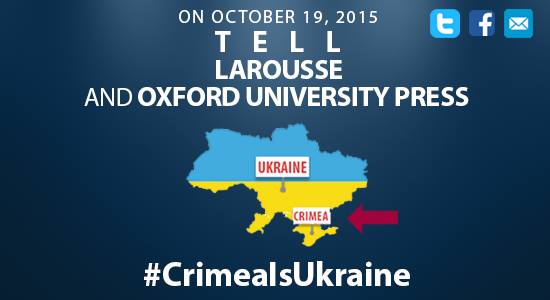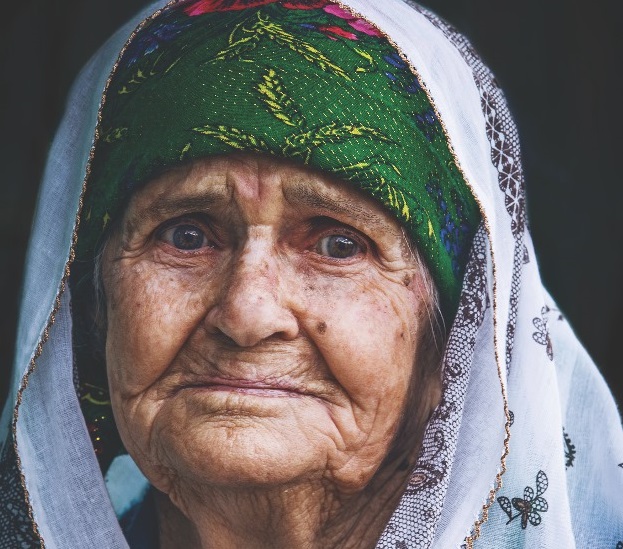The Dutch government will investigate the legality of the participation of two local companies in the construction of the bridge from Russia across the Kerch Strait to occupied Crimea, contravening EU sanctions, according to Foreign Trade and Development Cooperation Minister Lilianne Ploumen, the Dutch TV company NOS reported.
Minister Ploumen informed NOS that the Dutch government does not recognize the illegal annexation of the Crimea and "does not in any way stimulate activities that contribute to the normalization of the situation." She said that even if laws were not formally broken, the Dutch government expects companies to conduct socially responsible behavior.
The 19 kilometer-long Kerch Strait bridge, still under construction, is intended to cement Russia’s annexation of Crimea in March 2014, which the European Union regards as illegal along with most world countries. EU sanctions against Russia responding to the annexation were adopted in August 2014. Specifically, they prohibit new EU investments into infrastructure projects in Crimea and Sevastopol in the sectors of transport, telecommunications, and energy, as well as the sale, supply or transfer of key equipment and technology for the creation, acquisition or development of infrastructure projects in these sectors. In June 2017, EU foreign ministers extended sanctions against Russia for a further year. As well, a crony of Russian President Vladimir Putin was placed on the EU sanctions list over his company's participation in the construction of the Kerch Strait bridge.
According to the Dutch newspaper De Gelderlander, two companies are involved in the bridge's construction. Dematec Equipment had built a hydraulic impact hammer, which was shipped to Russia in early 2016 and had stamped heavy pipes into the seabed as a foundation for the pillars of the bridge. Dematec Director Derk Van den Heuvel said his company did not violate sanctions, as the equipment was assembled on Russian territory: "EU sanctions state that we are not allowed to work in Crimea, but we can in Russia," he said. Another company, Bijlard Hydrauliek, delivered "the most important part" for the hammer. Its director Marcel Bijlard said he did not know that his company's product would be used for the Crimean bridge, saying that they were "just delivered a part to a customer in the Netherlands. No more," indicating that the purchase was made through another company.
Grey territory with no penalties

De Gelderlander reported that several members of parliament reacted sharply to the news. Labour (PvdA) MP Kirsten van den Hul and Christian Democrat (CDA) counterpart Raymond Knops called for the role of the two companies to be investigated. "This bridge is the symbol of the Russian annexation. I want to know from the Cabinet whether this is legally allowed," said Van den Hul.
According to NOS correspondent David-Jan Godfroid, it is difficult to determine whether the companies violated EU sanctions or not, as the bridge was not built in Crimea, but in the sea, and as the sanctions are a relatively new idea, no penalties have yet been applied for their violation, and the European Commission needs to answer many questions before taking action against the companies.
But lawyer Heleen over den Linden, who specializes in sanctions law, told De Gelderlander that the whole construction of the bridge, directly or inderectly, including on Russian territory, is covered by the sanctions, which are hard to circumvent: "Otherwise, everyone would just distribute the goods via other countries bordering Crimea and send it through. Then the whole scheme would not work. You can't just hide by saying you did not know the sanctions. Only if you did not know completely and could not know what your goods are used for, you could be justified."
Back in December 2014, the Dutch outlet NlTimes reported that despite sanctions, Dutch companies maintained warm relations with Crimea, which has a great need for foreign expertise in the areas of energy, water management, and road construction. According to the outlet, unofficial small trade missions to Crimea were led by the Russian trade representative in the Netherlands. Citing lawyer Heleen over de Linden, the outlet wrote that many companies search for ways to circumvent the sanctions, one of the possible ways being to operate through a Russian entity, so that no EU citizen is directly connected to the sanctions breach.
The case of the bridge closely resembles the recent sanctions breach scandal with the German technogiant Siemens, which supplied turbines to two power stations under construction in occupied Simferopol and Sevastopol. Siemens claims that it has been duped by its Russian partner, which had illegally delivered to Crimea the heavy-duty gas turbines that a daughter company of Siemens
had produced for a power station in Taman, across the Kerch Strait. However, there is much evidence that Siemens was aware where the turbines are going to be used, and has likely willingly participated in the scheme from the start. So far, the Siemens scandal has ended with a minor extension of EU sanctions to several more Russian figures, but no legal action against the company itself. Then, the European Commission said that individual EU states are responsible for their companies complying with the sanctions regime.
More details in our investigation: How Siemens chose to ignore the obvious. An investigation into the Crimean sanctions break
Important case for The Netherlands

Unlike Germany, The Netherlands has ordered a probe into the violation of the sanctions regime by its companies. Conducting the probe diligently would be of particular importance for the country, after airliner MH17 was shot down on its route from Amsterdam to Kuala-Lumpur, supposedly by Russian-backed militants, above eastern Ukraine in July 2014. All 298 people on board were killed; 196 of them were Dutch citizens.
In October 2015, the Dutch Safety Board published a report on the reasons of the catastrophe which established that the airplane was shot down by the Russian Buk MLRS complex.
Later, experts from the Bellingcat investigative community concluded that the top brass of the Russian army carries part of the responsibility for the catastrophe in a report identifying 20 Russian servicemen as being involved in the transportation and operation of the Buk complex to Donbas by the 53d brigade, topping off the list of culprits with Russian Defense Minister Sergei Shoigu and two deputies - Valery Gerasimov and Arkadiy Bakhin, as well as Russian President Vladimir Putin, who is the Supreme Commander-in-Chief of the Russian Armed Forces, according to the Russian Constitution.
In 2017, the materials in the MH17 case were transferred to a Dutch court, and the authorities have declared that bringing those responsible for shooting down the civilian airliner to responsibility will be a priority for the government.
Other implications for The Netherlands

Apart from this, the Kerch bridge may become a new hot spot in Ukrainian-Russian relations. The final stages of its completion require shutting down sea travel through the Kerch Strait, including for ships heading to the Ukrainian port of Mariupol. And after it is completed, the bridge will limit the height of ships capable of entering the Azov Sea.
According to the Ukrainian Foreign Ministry, 23 days without sea travel in the Azov Sea amounts to nearly $20 mn of losses for Ukrainian state ports on the Azov Sea coast. Ukraine is preparing claims for international arbitration on violation of international maritime law. If the fault of the Dutch companies in violating sanctions is proven, they face not only fines but also image losses, as they will be complicit in violating international sea laws.
Russian President Vladimir Putin announced of Russia's intentions to build a bridge across the Kerch Strait right after the occupation of Crimea in March 2014. Ukraine withdrew from the 2013 agreement with Russia on building the bridge after the illegal landgrab. The construction is planned to be finished in 2018, and the bridge was planned to start operating by 2019.

The project envisions that a bridge with sections for rail and car transport will connect the Kerch and Taman peninsulas, crossing the channel of the Kerch Strait, passing through the island of Tuzla in the middle.
Work on the bridge's construction started in March 2016. The first bridge support was finished by 12 April 2016. By August 2017, the bridge was half-done. The main construction work was finished for 10 out of 19 kilometers of the object, with only minor operations remaining.





